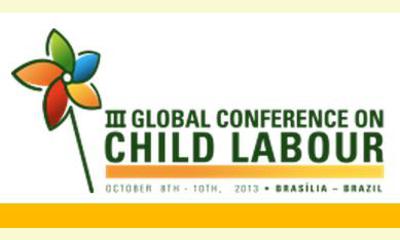|
|
Global conference, including teachers, commits to fight child labour
un article par Education International (abridged)
Over 1,200 representatives of governments,
workers, employers, and civil society from across
the globe gathered at the Third Global Conference
on Child Labour, held from 8-10 October in
Brasilia, Brazil. Thanks to a successful advocacy
effort by the education union delegation and the
support from other stakeholders, social dialogue
and teacher training were included in the final
declaration. . . .

click on photo to enlarge
A strong delegation of education union
representatives from 14 countries highlighted the
key role of universal free quality education, as
well as the need to involve teachers in the
elaboration of education policies as indispensable
tools to effectively eradicate child labour.
The Conference was opened by Dilma Rousseff,
President of Brazil, and Guy Ryder, General Director
of the International Labour Organisation (ILO).
The global number of child labourers had dropped
from 246 million to 168 million over the last
decade, said Ryder, referring to the ILO’s recent
report, ‘Marking progress
against child labour’.
The “bad news”, he explained, is that this will not
be enough to achieve the goal of eliminating the
worst forms of child labour by 2016, as agreed by
the international community through the ILO.
Ryder highlighted the importance of states working
to “fulfill their obligation to ensure universal
access to compulsory, formal education for all
children up to the minimum age for work, and to
improve the quality of education”.
Significant investment is required to achieve
this. “We need 1.7 million more qualified
teachers, at least”, he said. “We need to train
and qualify the huge number of teachers who are
unqualified. We need to make schools safe and
joyous places for children.” . . .
Panellist Kailash Satyarthi told that conference:
“We won’t eliminate child labour until we have
universal education. And we won’t get every child
into school until we eliminate child labour.”
A tireless activist and co-founder of the 80,000km
long Global March Against Child Labour, Satyarthi
has played a significant role in linking the fight
against child labour with the efforts for achieving
Education for All. . .
On the last day of the Conference, former
Brazilian president Luiz Inácio Lula da Silva
delivered a vibrant closing speech. “There is not
a lack of resources, but a lack of political will
to end child labour worldwide”, Lula pointed out.
The Declaration of Brasilia, a final statement
expressing the commitment of the countries to the
sustainable eradication of child labour, was
outlined. This document will guide and support
future efforts to eliminate child labour
worldwide. . . .
To read the full declaration please go here
To see the picture gallery of the conference
please go here
[Note. Thank you to Janet Hudgins, the CPNN
reporter for this article]
(Click here for a Spanish version of this article or here for a version in French )
|








|
DISCUSSION
Question(s) liée(s) à cet article:
Rights of the child, How can they be promoted and protected?
* * * * *
Commentaire le plus récent:
The Convention on the Rights of the Child was adopted by the United Nations General Assembly in 1989, as an important addition to the Universal Declaration of Human Rights.

|
|









